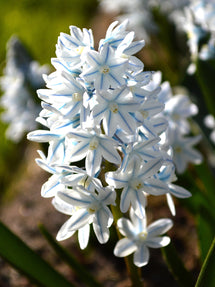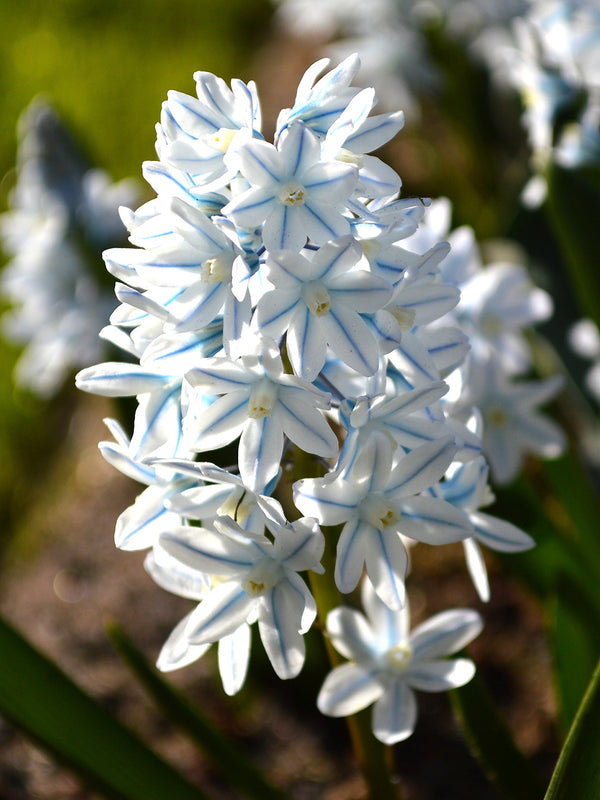Puschkinia (Striped Squill)
After the long, dark days of winter, Puschkinia brings gentle beauty to gardens across the United States. The plant's delicate tepals open like stars across the ground in early spring—subtle, elegant, and full of promise. Whether you plant a handful or a sweeping drift, these low-maintenance flowers return each year, slowly spreading and brightening quiet corners.
Showing 1 - 1 in 1 items
Puschkinia Libanotica - Striped Squill Bulbs
Puschkinia: Petty Bloom, Powerful Presence
Puschkinia is a small genus of bulbous perennial plants in the Asparagaceae family, named after the Russian botanist Apollo Mussin-Pushkin. Native to the mountainous regions of the Middle East, including the Caucasus, Turkey, Iran, and Lebanon, these plants have a powerful presence despite their small size. Puschkinia is closely related to Chionodoxa and Scilla, and is hardy in USDA zones 3-8. Its quiet presence adds a graceful touch to any garden, especially when planted where early blooms are most appreciated.
Puschkinia features star-shaped flowers atop slender green stems, and the tepals range in color from pale blue to white. Its narrow, grass-like foliage remains close to the ground, offering an understated aesthetic. This versatile plant thrives in a variety of settings, including rock gardens, among shrubs, at the base of deciduous trees, and in pots or containers. It is a spectacular plant when planted en masse. Puschkinia is particularly striking when paired with Daffodils or early Tulips, creating a beautiful contrast in shape and color. It subtly enhances the garden's overall appeal without dominating other plantings.
A Genus Containing Four Beautiful Species Of Bulbous Perennials
The genus Puschkinia includes four known species of small, spring-blooming perennials: Puschkinia “Bilgineri”, Puschkinia “Kurdistanica”, Puschkinia “Peshmenii”, and Puschkinia “Scilloides”. Though each species is slightly different, they all share the same quiet charm and reliable early flowering.
Puschkinia Scilloides: The Well-Known Star Of The Show
Of all the species, Puschkinia “Scilloides” is the most widely grown and cherished. Often known as “Striped Squill,” “Russian Snowdrop,” or “Lebanon Squill,” it’s among the earliest to bloom, sometimes appearing in late winter. This dependable bulb naturalizes gracefully, returning year after year in gradually expanding clusters.
At first glance, the flowers may appear white, but a closer look reveals silvery blue petals, each marked by a fine sky-blue stripe down the center. Reaching just 5 to 10 inches in height, it makes an excellent low-growing ground cover. Puschkinia Scilloides thrives in various garden settings, as long as the soil drains well, and naturalizes best under mature trees. At DutchGrown, we supply the award-winning Puschkinia Scilloides “Libanotica” variety, which is carefully selected for its lovely, clean, spicy fragrance and reliability in the garden.
Read more: Puschkinia 'Striped Squill', The Quiet Charmer
How To Plant Puschkinia For Maximum Effect In Your Garden
To grow Puschkinia bulbs successfully, timing and placement are crucial. This means you should plant the bulbs in the fall, before the ground freezes, to allow time for strong root development.
Begin by selecting a location with well-drained soil and full sun to partial shade. Under deciduous trees or along the edge of a woodland path works well. Next, plant each bulb about 3 inches deep, following the general rule of burying bulbs at a depth twice their height. Space them 4–5 inches apart in borders or flower beds. In containers, you can position them slightly closer together for a fuller display. Ensure the bulbs are planted with the pointed end facing up. Once planted, thoroughly water the area to help the soil settle. Striped Squill prefers a moist environment; ensure the bulbs receive regular watering after planting, but avoid overwatering to prevent waterlogging.
After flowering, each leaf turns yellow and dies back. During this period, reduce watering and let the bulbs rest. You can tidy up the faded foliage or let it break down naturally. Would you like to learn more about this beautiful plant? Read our growing guide “How to Grow Puschkinia Bulbs”.
Buy Top-Quality Puschkinia Bulbs At DutchGrown
Do you want to grow charming Puschkinia bulbs in your garden? At DutchGrown, you can find the highest-quality Striped Squill bulbs for sale. We carefully select our bulbs for their strength, reliability, and beauty in bloom, and we only supply the largest bulbs available (bulb size is 2-3 inches). Whether you’re a beginner or an experienced gardener, our commitment to quality will help you succeed. With DutchGrown, you can garden with tradition, knowledge, and care. We ship throughout the US.
Frequently Asked Questions About Puschkinia
Is Puschkinia Invasive?
Puschkinia is not invasive. Although it multiplies over time, it is generally easy to control if necessary. Puschkinia spreads gently through self-seeding and bulb offsets, forming larger clusters each year. This makes it ideal for naturalizing in borders, under trees, or along pathways. It offers long-term beauty without overwhelming other plants in your garden.
Is Puschkinia A Perennial?
Puschkinia is a perennial bulb that reliably returns each year. With well-drained soil and a spot that receives light shade or full sun, it blooms from late winter to early spring. Puschkinia is hardy in USDA zones 3 to 8.
When To Plant Puschkinia?
Plant Puschkinia bulbs in the fall, ideally before the ground freezes. This allows the bulbs to develop roots before winter arrives. A well-timed planting ensures healthy growth and early blooms in late winter or early spring. For optimal results, select a well-draining spot in your garden or a container, and plant the bulbs at a depth of 3 inches before the first hard frost.
Do Deer Eat Striped Squill?
Deer typically do not eat Striped Squill (Puschkinia). These bulbs are naturally deer-resistant, making them a reliable choice for gardens where deer browsing is a concern. You can enjoy their delicate blooms worry-free.

